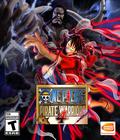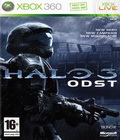Genre: First-Person Shooter
Publisher: Microsoft Game Studios
Developer: Bungie
Release Date: September 22, 2009
Halo has always been the story of the Master Chief; it began with him waking up from cryostasis, and it ends the same way. The Halo universe however doesn't quite revolve around the Master Chief, as a number of the side materials, such as the novels and comics, also involve other characters. The first game to feature a story that didn't center on Master Chief was Halo Wars, and even that focused heavily on his fellow Spartans. Halo 3: ODST is unique because it is the first Halo game to not feature a Spartan in a starring role. For the first time, we get to see what the rest of humanity can do without Spartans around to save their rear ends. While that may sound like a recipe for disaster, the human soldiers in Halo are not quite as doomed as one would think.
Halo 3: ODST opens up about two weeks prior to the start of Halo 3, in the skies over the city of New Mombasa. The player is put into the role of The Rookie, a member of the "Helljumper" Orbital Drop Shock Troopers, or ODST, a group of specialized marines who enter combat by dropping from orbit in special pods. "Firefly" fans will be glad to know that the ODST incorporates some familiar voice talent from the show, such as Nathan Fillion, Adam Baldwin and Alan Tudyk. The ODST was to be dropped onto a Covenant ship to aid in the fight, but the Covenant ship enters a warp before they can, knocking the ODST out of the air and causing massive damage to the planet below. The Rookie awakens hours later, trapped in the city of New Mombasa, separated from his team and surrounded by Covenant forces.
One of the most important things to remember about Halo 3: ODST is that you're not Master Chief. Every previous Halo title has put you in the role of that iconic hero, and it has reached a point where you associate certain powers with Halo. By and large, the biggest of these is the MJOLNIR combat armor. Unlike every other unlucky sap in the army, Master Chief got special super armor which, among other things, is equipped with automatically regenerating force fields. For those who don't really care about the Halo backstory, that is the explanation for why you recover health when damaged in Halo.
In ODST, however, you're not playing as Master Chief or any of Master Chief's fellow Spartans, so you don't have access to MJOLNIR armor. This means that unlike other Halo titles, The Rookie functions more like a classic FPS protagonist, complete with a health bar. As you take damage, you lose health, and you have to find health kiosks or health packs scattered around the stages to keep on your feet. This, more than anything, is going to change the way the game is played, as anyone who played the previous Halo titles is going to have to adjust their tactics and strategies to deal with the fact that they can't absorb damage as readily as before. The ODST also doesn't have the advantage of the Master Chief's super strength, so they can't dual-wield weapons or use special Covenant equipment, and they don't even have a built-in motion sensor. They can, however, still jack vehicles, even if Halo Wars established that as a special ability exclusive to Spartans.
However, the ODST members have some advantages over Master Chief. Unlike him, they are not propaganda symbols and don't have to be visible on the front lines at all times. Their job requires them to do things a bit more stealthily than Master Chief, so the ODST come armed with silenced weaponry, including a silenced SMG and a silenced pistol. It may not sound like a big difference, but the Covenant are not flawless machines, and if something is picking them off from the shadows, it makes it a lot harder for them to fight back. The ODST also has a special low-light visor that they can use to see in the dark. Beyond amplifying light, this visor also highlights objects of interest, including enemies and items. In short, the ODST is designed for a different play style from Master Chief, and they're built for stealth and tactical advantages instead of gigantic lasers and regenerating force fields.
This is a good thing, since The Rookie is dropped into a very bad situation. Unlike the other Halo games, you don't really have a set linear objective in ODST. Instead, you're dropped in the middle of the Covenant-infected New Mombasa and have to discover exactly what happened to the rest of your squad. Consequently, the Rookie's adventure is a lot more non-linear than Master Chief's. You're given a map of the city and can explore at will. It's not a Grand Theft Auto-style city or anything, but it is a more open area that's one of the biggest ever in a Halo title. Since you're alone and poorly supplied, you can't rush into combat and make a lot of noise, and so you'll have to take it slow through the city. His one advantage is New Mombasa's Supervisor AI, the computer intelligence in charge of running the city. The AI wants to help out and will spend its time pointing out objects of interest. This is done in a very interesting way, since The Supervisor has control over everything in the city. If a Covenant ambush is about to drop in on you, the Supervisor may change all of the local advertisements into a warning. If there is a path you have to follow, computer monitors may change into arrows for you to follow. The entire city is on your side, but unfortunately, that's a small advantage, especially for a lone grunt.
Your main goal in Halo 3: ODST is going to be finding evidence of what happened to the other members of the ODST. When you find a piece of evidence, the game's point of view changes to the member of the ODST to which that evidence is connected. For example, you may find a bomb detonator lying on the ground in front of a destroyed bridge. Picking it up will switch you over to the ODST member who detonated that. These "flashback" moments tell the story and give the players a chance to play a more traditional Halo style of combat. The demo has the player thrown into a tremendous firefight, where he has to hold off a Covenant assault force long enough to plant and detonate the bombs. It was classic Halo action through and through, and it should feel very familiar to franchise veterans, even with the modified health system. We've been told that you'll get a chance to play as every member of the ODST at least once, so expect quite a number of these full-on flashbacks.
Halo wouldn't be Halo without a multiplayer mode, and Halo 3 : ODST doesn't disappoint. The first notable thing about ODST is that it will include the Halo 3 Competitive Multiplayer Disc, which is a self-contained add-on that contains the entire Halo 3 multiplayer experience, including all of the little side features, such as The Forge and three new additional maps. Effectively, you won't need Halo 3 to play multiplayer anymore.
ODST will also include some substantial multiplayer action. There will be single-player co-op, but the real focus is going to be the new Firefight mode. It's a cooperative game mode where up to four players are thrown into a special map and must survive against a relentless swarm of Covenant forces. The game is divided up into sets, which are made up three rounds of five waves each. At the beginning of every round, a new set of semi-randomized Covenant forces come after you. Survive a wave and another comes, up until the fifth wave, or the "Chieftain Wave," which is the hardest to survive. Survive all five waves, and you advance to the next round. With each passing round, you may activate a new Skull, which are special added conditions to make the game more difficult. The basic goal is to survive however long you can under increasingly difficult circumstances. The entire team has a shared life pool, and each time one of your team dies, the entire team suffers. There are an infinite number of sets, so the game continues until the team falls. It's also worth noting that anyone who picks up Halo 3:ODST will earn a free entry into the upcoming Halo: Reach beta.
Halo 3: ODST looks to be an expansion pack done right. It uses the same basic gameplay engine, but changing the focus to an ODST rookie provides a very different gameplay experience. While our demo was short, we could already see the differences from a classic Halo title. It was slower, but no less intense, and there is something deeply satisfying about watching a skilled player take out Covenants with a quick, sneaky ambush. Even if you're not interested in the single-player mode, Halo 3: ODST offers a robust-looking multiplayer mode. On its own, Firefight looks like an exceptionally fun game mode, and earning a free copy of Halo 3's excellent multiplayer is almost worth the cost. Even gamers who are a bit tired of Halo will want to keep an eye on ODST, as the changes really do make it a different game, even despite all of the familiar elements.
More articles about Halo 3: ODST











 Halo 3: ODST (Orbital Drop Shock Troopers) is a new chapter in the Halo saga that lets gamers experience events leading up to the epic story told in Halo 3 through the eyes of a new hero in the Halo universe. The stand-alone expansion extends the Halo 3 experience with hours of new campaign excursions and multiplayer gameplay.
Halo 3: ODST (Orbital Drop Shock Troopers) is a new chapter in the Halo saga that lets gamers experience events leading up to the epic story told in Halo 3 through the eyes of a new hero in the Halo universe. The stand-alone expansion extends the Halo 3 experience with hours of new campaign excursions and multiplayer gameplay.




















